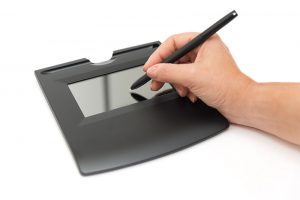
How Signature Verification Tools Detect Forgeries
Traditionally, banks had physical signature cards for every one of their account holders. These cards allowed bank employees to compare the account holder’s reference signature with the signature on the transaction. Many banks still have filing cabinets full of signature cards, but an increasing number of banks store reference signatures digitally.
Regardless of how you store account holders’ signatures, the signature continues to be important. In particular, it helps to establish the authenticity of transactions if someone makes a fraud claim. However, your team doesn’t have time to manually check the signature on every document that comes into your financial institution.
To save time and reduce the threat of fraud, there are signature verification tools that can work in the background. These tools compare the presented signature to the reference signature on file, and they alert your fraud control team if something seems wrong. Then, your team can do a manual review.
To help you understand how signature verification tools work, here is an overview of some of the elements they assess when analyzing signatures.
1. The Fluidity of the Signature
When assessing the legitimacy of a signature, analysts look at the following seven elements:
- Speed
- Pressure
- Form
- Dimension
- Continuity
- Direction
- Order
Signature experts have been aware of these elements since the late 1800s. In other words, they’ve used these elements to assess the accuracy of signatures since long before the invention of computers.
As you can see, only a few of these elements relate to the look of the signature. Nearly anyone can mimic the look of a signature. They can copy it freehand or by holding a sheet of paper over the original signature. However, that won’t fool an experienced signature analyst because they also take into account how the signature was written.
In particular, they look at speed, pressure, and continuity. Generally, these elements are all sacrificed when a fraud artist painstakingly and slowly tries to copy the physical elements of a signature. To pass a verification test, the signature needs to be written fluently.
Humans can assess these elements — they’ve been doing it for over a hundred years. But it’s not reasonable to have your team manually look for fluidity. Luckily, signature verification tools can assess this element for you.
2. Dynamic Elements of the Signature
A signature has both static and dynamic elements. Static elements, as indicated above, generally refer to the look of the signature. They include its height, width, slants, strokes, and the order of various elements.
In contrast, dynamic elements refer to how the signature was written. They can include speed, pressure, and characteristic gestures. Signature verification tools can compare both the static and dynamic similarities of presented and reference signatures.
3. Geometric Similarities and Differences
To assess geometric similarities or differences between signatures, signature verification tools identify distinctive spots or nodes on signatures. Then, they draw triangles between three nodes on the signature.
When assessing a genuine signature, the tools note that the triangles are the same between the presented and reference signatures. This works even if the signatures are different sizes. They just need to be the same shape.
In contrast, if the triangles are not the same, the system will notice the discrepancies, and it can flag the transaction for manual review.
4. Signature Segmentation
This type of analysis segments the presented and reference signatures, and it looks for differences and similarities between each of the segments. Segmentation can be especially useful in situations where analyzing the whole signature doesn’t create a conclusive response.
5. Descriptive Language.
With descriptive language signature analysis, each element of written signatures is assigned a hieroglyphic. When the signature verification tool analyzes a signature, it creates a sequence of hieroglyphics that indicate the elements used in the signature.
By comparing the hieroglyphics assigned to the reference signature and the presented signature, the application can spot minute discrepancies. Generally, these issues are not visible to the human eye.
6. Customizable Parameters
When you have signature verification tools working in the background, they can assess every single signature that comes through your financial institution. Using multiple analytical methods as explained above, these tools look for discrepancies between reference and presented signatures, and they present potential forgeries to your team for manual review.
However, you may want your team to manually review other types of transactions. You can do this if you have a signature verification tool with customizable parameters. For instance, you may want the tool to request manual verification on every check over a certain amount or checks presented on dormant accounts.
7. Machine Learning
Machine learning is a type of artificial intelligence that allows your signature verification tools to improve their approach over time. To give you an example, imagine your signature verification tool flags a signature as potentially fraudulent, but your human team member says the signature is fine. The tool will learn from this experience. It will produce fewer false positives over time.
The use of signatures has changed dramatically over the last decade. Now, digital signatures and e-signing are more common than ever before, but the traditional signature continues to persist.
Does your financial institution have tools in place to assess the accuracy of signatures? Do your signature verification tools assess dynamic elements? Do they incorporate machine learning and allow you to customize parameters? If not, your bank may be vulnerable to fraud.
We can help. At SQN Banking Systems, we offer signature verification tools as well as other anti-fraud solutions. To learn more or to get a fraud process analysis, contact us today. We’ll help you fight fraud so you can focus on running your financial institution.
